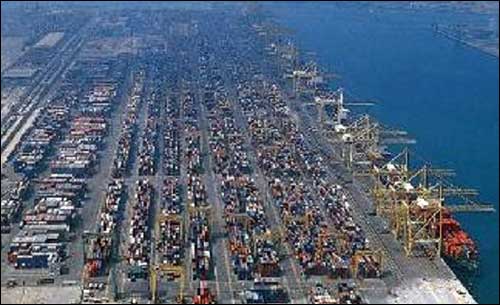DP World, which operates 50 ports in 27 countries, is expanding its RFID use to increase security and speed up the entry and exit of trucks at its Jebel Ali terminal, in Dubai. Based on the experience it has gained from implementing this active RFID application at gates in a section of the terminal known as T2, the terminal operator is now deploying the system at gates in another area, called T1. The expansion rollout should be finished by the end of 2009, according to Rashid Bin Saifan, a manager in the documentation section of DP World’s commercial department.
The company’s Jebel Ali terminal serves the world’s largest manmade harbor and the biggest port in the Middle East. The RFID application is one of a series of IT-based applications designed to automate procedures and processes at DP World. For instance, the company offers online payment and gate booking.
Roughly 12,000 trucks that visit the Jebel Ali terminal have been outfitted with active RFID tags provided by Identec Solutions. The tags are mounted on the rear chassis of each vehicle. Mike Dempsey, Identec’s director for ports, marine and intermodal business, says that as a driver approaches an entrance or exit, the truck’s tag ID number is read by an RFID interrogator integrated with an automated gate system provided by Science Applications International Corp. (SAIC). The tags operate at 868 MHz—the frequency slotted for such uses in Dubai—and include 125 kHz receivers for position recognition via loops in the ground in gate lanes. The loops help to improve the discrimination of trucks in gate lanes, Dempsey explains.
At the gate, an optical character recognition (OCR) system reads the ID number of the container the truck is carrying. It determines if the vehicle is indeed loaded with a container, and reads the truck’s license plate number as backup identification.
The system then links the truck’s tag ID number with the container’s ID. At the gate check-in pedestal, a driver shows his ID card or provides a PIN number sent from the dispatch company to his cell phone via a text message. The information is used to pull up an electronic job ticket, or job assignment, from the database. Once the transaction is confirmed, the driver is given a printed ticket that instructs him where in the terminal to go in order to fulfill his assignment.
“The idea,” Dempsey says, “is an RFID tag as a license plate for multi-step gate transactions.”
As the truck leaves the terminal’s central area, its RFID tag is read once more, and the driver receives a receipt regarding the transaction from a pedestal at the gate.
Before RFID was implemented, drivers would approach the terminal gate and make a stop to receive paper-based instructions regarding what to pick up or drop off. They stopped again upon checking out of the site, once their work was completed. “The system eliminates most paperwork for drivers,” Bin Saifan says, “and saves an average of 10 minutes per inbound and outbound load.”
If the driver of an untagged truck wants to enter the facility, that vehicle is assigned a temporary tag upon payment of a deposit. This deposit is refundable when the driver exits and returns the same RFID tag to the company.
One reason DP World chose radio frequency identification for the job, Dempsey says, is that an OCR system would not always successfully read a truck’s license plate, since the vehicles may carry their plates in different positions, such as inside the windshield.
According to Bin Saifan, the main benefits of the project, which developed from an idea the company had in 2004, are improved efficiency and truck turnaround times, the elimination of waiting at terminal gates for drivers, increased vehicle fuel efficiency and higher customer satisfaction levels, as well as a chance for the transport companies to increase their revenue and reduce costs through time saved by using RFID. In addition, he notes, the system helps DP World be prepared to scale up quickly for higher freight volumes, if necessary.
At some point, the system could also be employed as a basis for automating additional processes. DP World could set up a fully automated container hand-off system, for instance, in which a truck’s RFID tag would be read at the point that containers are to be loaded onto or unloaded from a truck within the terminal.
In the unloading area, for example, an RFID interrogator could again collect the truck ID information already linked to the container ID during the check-in process at the gate. That data, Dempsey explains, would provide the container-handling equipment (CHE), such as lifting arms or cranes, with instructions regarding what to do with the container—that is, unload it and move it to a particular position.
DP World is also deploying Identec’s RFID technology at other terminals it operates (see RFID Boosts DP World’s Productivity in Australia).



